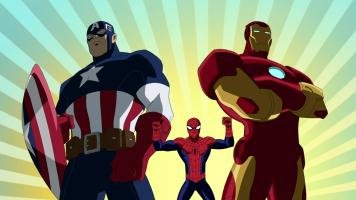
CHARACTERS · EPISODES · GUIDES · MEDIA · RELEASES · BACKSTAGE · FORUM A series of chats with Man of Action Studios, the creators behind Ultimate Spider-Man! Collectively known as Man of Action Studios, the team of Duncan Rouleau, Steven T. Seagle, Joe Kelly and Joe Casey serving as Supervising Producers on Ultimate Spider-Man have worked together in the world of animation for years, creating such shows as Ben 10 and Generator Rex. Besides his work as a writer and Supervising Producer on Ultimate Spider-Man, Duncan Rouleau has worked as an artist on a number of Marvel heroes—and anti-heroes—including runs on Alpha Flight, Venom, X-Factor and more. Now he makes his return to the Marvel Universe helping to bring your Friendly Neighborhood Wallcrawler to animated life. Marvel: While the majority of your work in comics has been as an artist, early on you helped co-plot Alpha Flight with Steven Seagle and have written a number of things on your own since then. How do you think your skill sets as an artist have helped inform your writing, both for comics and animation? Duncan Rouleau: Having a “visual eye” does not exclusively belong to an artist, but the day-to-day practice of taking a written idea and translating it into a visual representation allows me a no-nonsense approach on how things can be best realized, especially [when] constructing massive super hero tales that require loads of action and fight choreography. But truly, the greatest advantage being an artist in comics allowed me the opportunity to work with many great writers and see firsthand their storytelling process—some of whom are now members of Man of Action. Marvel: Before Ultimate Spider-Man, I don’t believe you had the opportunity to work on the Wallcrawler much—what have you enjoyed most about writing him so far? Duncan Rouleau: I love working on this show! The entire process from breaking stories in the writer’s room to seeing the finished product has been so much fun. I think the show reflects that. There are many untapped aspects of Spidey’s character that appear in the comics that have not been seen in the in any of the animated versions --yet. The use of quick cutaways and a rich inner fantasy life have allowed us to explore Spidey’s famous irreverent humor and humanity in a way that hasn’t ever been visualized in a super hero show before. For me, helping establish this new way of telling a Spidey story has been the most entertaining and challenging [aspect]. Marvel: What are some of your personal favorite Spidey stories? What about favorite writers or artists who have worked on the webhead? Duncan Rouleau: No real surprises here. There have been many classic runs and I am a fan of every one of them. I first ran into Spidey somewhere in the mid-70s and have been following his exploits since. I do have a sweet spot for the early [Steve] Ditko/[Stan] Lee books, but if I was cornered I’d have to say Amazing Spider-Man #121 through #180 are some of my favorites. Marvel: When you set out to write something, do you already have a clear visual of what’s going to happen beforehand? Duncan Rouleau: A good story always springs out from an idea--a “hook”--that first draws you in. That hook could be an image, a character moment or even a question. Once you have that, and it’s one you are excited by, the story can follow pretty quickly. From a practical writing method, when constructing a script--especially for animation--it’s always best to have the ending in mind before you start the plot. However, in many cases, I have made discoveries along the way that change the ending I had originally planned for…but those usually come out of the discovery of a new and better hook. Marvel: What are some of the biggest differences in your mind between working in comics and animation? Duncan Rouleau: That’s a really interesting question. However, I think the answer differs from project to project. The big challenge on doing Ultimate Spider-Man was actually taking specific storytelling elements found in comics--the thought balloon, the omniscient narrator, genre splicing, etc.—and embracing them and finding an animated equivalent. This approach has really opened up the floodgates for me. Without going too deeply into the storytelling techniques, we took a lead from the Ultimate Spider-Man comics. And hopefully, by embracing the spirit found in those pages, we’ve managed to imbue that energy into the Ultimate Marvel Comic animated show. I really can’t wait to see what people think of what we did. We’re very proud of it. Marvel: How has your work in comics influenced your work in animation, and vice versa? Duncan Rouleau: I find animation to have a very precise approach to storytelling. It might be because it is directly influenced by budgets and production schedules, but there is no wasted line of art, no wasted motion--it forces you to vet and analyze every aspect to create the maximum effect. Comics, for me, have provided an exploratory experience. Probably because there is a smaller crew and less technical layers involved, but I find the chance for personal discovery to be open wide working on a book. In the end, each has their challenges, but both are invaluable. I guess you could say one encourages my craftsmanship while the other my artistry. Together, hopefully, they have made me a better storyteller.
|
